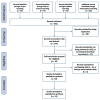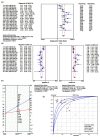Diagnostic and Prognostic Performance of Liquid Biopsy-Derived Exosomal MicroRNAs in Thyroid Cancer Patients: A Systematic Review and Meta-Analysis
- PMID: 34503104
- PMCID: PMC8428356
- DOI: 10.3390/cancers13174295
Diagnostic and Prognostic Performance of Liquid Biopsy-Derived Exosomal MicroRNAs in Thyroid Cancer Patients: A Systematic Review and Meta-Analysis
Abstract
Circulatory tumor-derived exosomal microRNAs (miRNAs) play key roles in cancer development/progression. We aimed to assess the diagnostic/prognostic value of circulating exosomal miRNA in thyroid cancer (TC). A search in PubMed, Scopus, Web of Science, and Science Direct up to 22 May 2021 was performed. The true/false positive (TP/FP) and true/false negative (TN/FN) rates were extracted from each eligible study to obtain the pooled sensitivity, specificity, positive/negative likelihood ratios (PLR/NLR), diagnostic odds ratio (DOR), and their 95% confidence intervals (95%CIs). The meta-analysis included 12 articles consisting of 1164 Asian patients and 540 controls. All miRNAs were quantified using qRT-PCR assays. The pooled sensitivity was 82% (95%CI = 77-86%), pooled specificity was 76% (95%CI = 71-80%), and pooled DOR was 13.6 (95%CI = 8.8-21.8). The best biomarkers with high sensitivity were miR-16-2-3p (94%), miR-223-5p (91%), miR-130a-3p (90%), and miR182-5p (94%). Similarly, they showed high specificity, in addition to miR-34c-5p. Six panels of two to four exosomal miRNAs showed higher diagnostic values with an area under the curve (AUC) ranging from 0.906 to 0.981. The best discriminative ability to differentiate between cancer and non-cancer individuals was observed for miR-146b-5p + miR-223-5p + miR-182-5p (AUC = 0.981, sensitivity = 93.8% (84.9-98.3), specificity = 92.9% (76.5-99.1)). In conclusion, the expression levels of exosomal miRNAs could predict TC.
Keywords: exosomal microRNAs; liquid biopsy; meta-analysis; miRNA; thyroid cancer.
Conflict of interest statement
The authors declare no conflict of interest.
Figures







References
-
- Papini E., Guglielmi R., Bianchini A., Crescenzi A., Taccogna S., Nardi F., Panunzi C., Rinaldi R., Toscano V., Pacella C.M. Risk of Malignancy in Nonpalpable Thyroid Nodules: Predictive Value of Ultrasound and Color-Doppler Features. J. Clin. Endocrinol. Metab. 2002;87:1941–1946. doi: 10.1210/jcem.87.5.8504. - DOI - PubMed
Publication types
Grants and funding
LinkOut - more resources
Full Text Sources
Miscellaneous

